
Senior Capstone Projects (2007-2008)
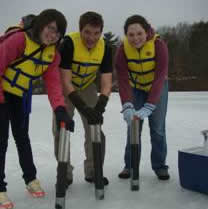 The Distribution and Accumulation of Copper in the Bottom Sediments of Loughberry
Lake, Saratoga Springs, NY
The Distribution and Accumulation of Copper in the Bottom Sediments of Loughberry
Lake, Saratoga Springs, NY
Noah Novotny, Leah Wohl-Pollack, and Whitney Eliot(2008)
Copper sulfate has been used for over 40 years in Loughberry Lake as an algaecide. This project analyzed copper concentrations in sediment samples extracted from cores taken from Loughberry Lake. We determined if and how copper has accumulated in the bottom sediemnts over time and related it to copper sulfate application history in order to better understand copper's possible impact on the lake ecosystem.
Full report is not available. Please contact Cathy Gibson for more information.
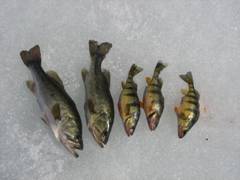 Copper Concentrations in Five Freshwater Species from Loughberry Lake, Saratoga Springs,
NY
Copper Concentrations in Five Freshwater Species from Loughberry Lake, Saratoga Springs,
NY
Charles Gouin and Matthew Helterline (2008)
We examined the concentration of copper in the tissue of five aquatic species in Loughberry Lake, and three species from Lake Lonely. The species belong to various trophic levels, allowing us to detect any evidence that copper is biomagnifying. We examined muscle and skin tissue separately from the organ tissue so that these concentrations could be compared.
Full report is not available. Please contact Cathy Gibson for more information.
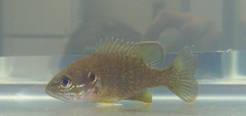 Impacts of Copper Sulfate on the Feeding Efficiency of Juvenile Bluegill Sunfish
Impacts of Copper Sulfate on the Feeding Efficiency of Juvenile Bluegill Sunfish
Elizabeth Stoner and Elizabeth H. White (2008)
Dissolved copper can damage the olfactory and visual systems of fish at low concentrations. We examined the impact of copper sulfate, a common algaecide, on the foraging behavior of juvenile sunfish. Foraging efficiency influences fish health and food web dynamics, and therefore can suggest changes in ecosystem functioning.
Full report is not available. Please contact Cathy Gibson for more information.
 A Phosphorus Budget for the Saratoga Lake Watershed
A Phosphorus Budget for the Saratoga Lake Watershed
Eric Jenks (2008)
This study created a phosphorus budget for the Saratoga Lake watershed by finding the differences between the amount of phosphorus entering the watershed and the amount exiting the watershed. It found that there is a substantial amount of phosphorus being left behind in the watershed each year by fertilizers and faulty septic systems.
Full report is not available. Please contact Cathy Gibson for more information.
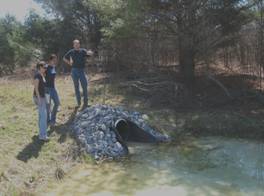 Assessing Stormwater Runoff and Policy in the Kayaderosseras Watershed, New York
Assessing Stormwater Runoff and Policy in the Kayaderosseras Watershed, New York
Meghan Lena, Jessica Morten, and Angela Polletta(2008)
Our study examines the impact of land-use on stormwater runoff in the Kayaderosseras watershed using the Long-Term Hydrologic Impact Assessment (L-THIA) model. We also examine local management goals aimed at fulfilling federal and state stormwater policy and assessed implementation success based on town annual reports. We interviewed local officials and site inspectors regarding the challenges of implementing local stormwater management policies, and in particular, sediment and erosion control at construction sites.
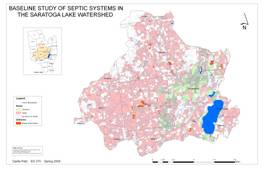 The Environmental Impact of Septic Systems on the Saratoga Lake Watershed
The Environmental Impact of Septic Systems on the Saratoga Lake Watershed
Dante Petri (2008)
I examined the environmental impact of septic systems on the Saratoga Lake watershed. Using GIS, I developed an estimate of the total number of septic systems in the watershed. I estimated the effectiveness of septic system in treating wastes using interviews with local septic contractors and scholarly research.
Full report is not available. Please contact Bob Turner for more information.
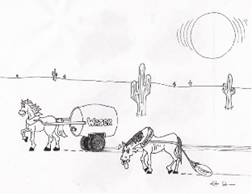 What to do about a Drought in a Bout of Drought: Understanding Drought in a Water-Rich
Region
What to do about a Drought in a Bout of Drought: Understanding Drought in a Water-Rich
Region
Andy Hart and Kate Stevens (2008)
This study explores the causes of drought in Saratoga and how the city responds to instances of drought. Our results reveal that drought in Saratoga can be affected by precipitation, population growth, water consumption, and Loughberry Lake’s storage capacity. Drawing from interviews with Public Works officials, we learn that the city manages small drought periods with mainly reactive responses. In order for the city to have a genuine proactive drought management policy, a larger water source with more storage capacity is needed to both store water and provide guaranteed water for the citizens of Saratoga in a time of severe drought.
Full report is not available. Please contact Bob Turner for more information.
What to do about a Drought in a Bout of Drought: Understanding Drought in a Water-Rich Region
Andy Hart and Kate Stevens (2008)
This study explores the causes of drought in Saratoga and how the city responds to instances of drought. Our results reveal that drought in Saratoga can be affected by precipitation, population growth, water consumption, and Loughberry Lake’s storage capacity. Drawing from interviews with Public Works officials, we learn that the city manages small drought periods with mainly reactive responses. In order for the city to have a genuine proactive drought management policy, a larger water source with more storage capacity is needed to both store water and provide guaranteed water for the citizens of Saratoga in a time of severe drought.
Full report is not available. Please contact Bob Turner for more information.
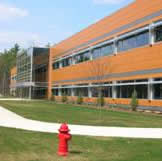 Projects and Perspectives that are Shaping Smart Growth in Malta, New York
Projects and Perspectives that are Shaping Smart Growth in Malta, New York
Sophia Wiley (2008)
I examined the prospects for smart growth in Malta, New York by conducting analyses of projects Steeplechase at Malta and Luther Forest Technology Campus, and by conducting interviews with elected officials and stakeholders in Malta. My research has found that these projects and envisioned plans for growth simultaneously complement and deviate from the principles of smart growth.
Full report is not available. Please contact Bob Turner for more information.
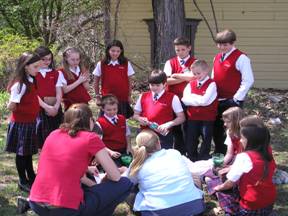 A Watershed Education Guide for Saratoga Lake
A Watershed Education Guide for Saratoga Lake
Lauren Fletcher and Sieglinde Mueller (2008)
The Saratoga Lake Watershed Education guide was created through an analysis of existing environmental education curricula and tailoring the activities to 3rd, 4th, and 5th grade students within the local watershed. The project culminated in a 32-activity education guide that incorporates indoor and outdoor activities and focuses on hands-on learning. The activities were field tested at two local elementary schools: Saratoga Independent School in Saratoga Springs, NY, and Saint Mary’s School in Ballston Spa, NY.
Summer Collaborative Research (2008)
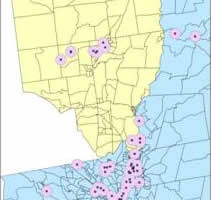 Environmental Justice Along the Hudson River
Environmental Justice Along the Hudson River
Katarra Peterson ’09, Mary Rynasko ’11 and Rik Scarce, Associate Professor of Sociology (2008)
“Environmental justice” is an area of sociological study combining race, class, and the environment. It hypothesizes that minorities and the poor are disproportionately burdened by environmental hazards. The goal of this project is to explore how environmentally just or unjust the Hudson River region is. The research involves using geographic information systems (GIS) and U.S. Census Bureau data sets to map the locations of polluting facilities and the demographics of the neighborhoods around them. Results are organized by facility type and have thus far indicated that the environmental justice hypothesis is accurate for the Hudson region.
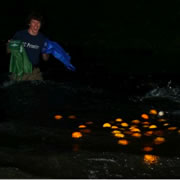 Distribution and Ecology of Riparian Invaders in the Upper Hudson Watershed
Distribution and Ecology of Riparian Invaders in the Upper Hudson Watershed
Emily Rollinson ’09, Dan von Allmen ’09, and Josh Ness, Assistant Professor of Biology (2008)
Japanese knotweed (Fallopia japonica) is a water-borne exotic weed currently invading the riparian zones in the United States and Europe. We mapped the distribution of knotweed in nine Upper Hudson watersheds, and discovered that invasions were more common in larger streams (third to fifth order) and along the depositional banks of meandering stream reaches. We attribute both patterns to within-stream increases in the delivery of plant fragments. We also found that knotweed-invaded riparian zones differed from their non-invaded counterparts, with fewer herbaceous species, fewer woody seedlings, and less light reaching the forest floor. These invasions may reconfigure riparian communities.
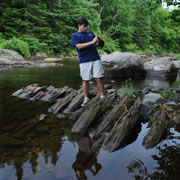 Logging, Dams, and Jams: What Was the Geomorphic Impact of Adirondack Logging on Hudson
River Headwater Streams?
Logging, Dams, and Jams: What Was the Geomorphic Impact of Adirondack Logging on Hudson
River Headwater Streams?
Matthew Shrensel ’09 and Kyle Nichols, Associate Professor of Geosciences (2008)
Adirondack logging from the early 1800s-1950 used waterways to drive logs through terrain too rugged and remote for overland transport. To facilitate log transport, dams were constructed to release water during spring melt. Such an increase of peak discharge may have had a lasting effect on drainage morphology and sediment distribution. Our goal was to develop a database of logging dams that were used during this time. We used several different means to acquire dam locations such as: literature, interviews with local ‘experts’, classifieds and web forums, and developing our own criteria based on basin morphology from topographic maps and aerial photographs. To date we have over 80 confirmed and potential sites.
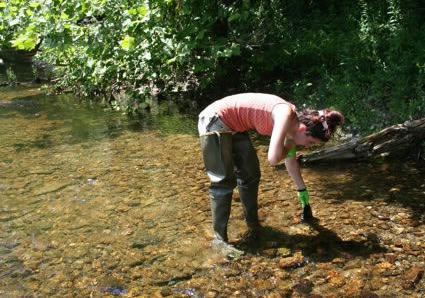 Impact of Invasive Diatom on Stream Food Web and Community Structure
Impact of Invasive Diatom on Stream Food Web and Community Structure
Hannah Harris ’10, Emily Stulik ‘10, and Cathy Gibson, Assistant Professor of Environmental Studies (2008)
In the summer of 2007, Didymosphenia geminata, an invasive algae also known as “rock snot” was found on the Batten Kill River near Salem, NY. Previous research has shown that invasions of D. geminata can alter the structure of the macroinvertebrate community by contributing to the decline of other species such as mayflies, stoneflies, and caddisflies. To determine the impact of the invasion on the macroinvertebrate community of the Batten Kill, we sampled four similar sites with varying levels of invasion. Both the diets and the community structure of D. geminata were analyzed. Preliminary results suggest that some species may be capable of limiting the growth of D. geminate through grazing, and that the presence of D. geminata, even at low levels, decreases the abundance of macroinvertebrates in the river.
 Capturing and Preserving History in the Upper Hudson River Valley: Development of
a Historic Map Database Using Geographic Information Systems
Capturing and Preserving History in the Upper Hudson River Valley: Development of
a Historic Map Database Using Geographic Information Systems
Lyndsay Strange ’09 and Alex Chaucer, GIS Instructional Technologist (2008)
The Upper Hudson River valley has a rich history of industrial, commercial, residential and recreational impacts at different stages in time throughout the watershed. When studying this geographic area there currently is no centralized resource to suggest watershed impacts organized in a temporal and geographical context. Historic maps contain much of this valuable reference information, yet there is no centralized resource for searching these documents, and often access involves a physical visit to view the document. By contacting private collectors and public libraries’ archives, we are able to locate and access fragile historic maps. This projects aims to collect this historic cartographic information digitally, reference it geographically, maintain it centrally, and present this information in usable format for future research purposes.
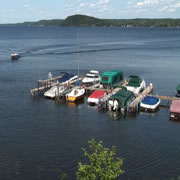 The Saratoga Lake Watershed: Connecting Biodiversity and Community
The Saratoga Lake Watershed: Connecting Biodiversity and Community
Jonathan Betz ’09 and Chris Grassi, Visiting Assistant Professor of Anthropology (2008)
The proximity and local debates over the uses of Saratoga Lake and its watershed provide an opportunity to educate both the Skidmore and local community about the connections between water, local wildlife, people, and land use. Therefore we are producing an educational film about the physical, biological, and social aspects of this watershed. We have conducted 17 formal interviews and recorded over 30 hours of film. These will be used to represent the ways in which people interact with the watershed and the interests of these different stakeholders. We have identified themes within these perspectives that demonstrate links and conflicts in viewpoints.